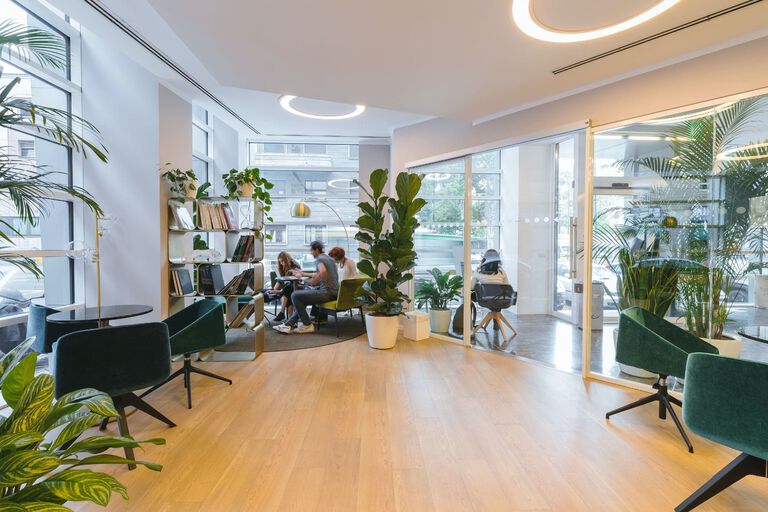HOW TO ENTICE EMPLOYEES BACK TO THE OFFICE
What to do when your employees aren't rushing to return to the office
5 minute read
What to do when your employees aren't rushing to return to the office
Working culture has changed forever, bringing universal uncertainty to the future of work. Currently, only two things are sure — a great workplace is essential, and hybrid working is here to stay. In their Global Workplace Survey, Gensler polled 10,000 office workers and found that most of them want a hybrid working model, and the office is still the best place to collaborate and connect.
The need for the right space to meet and collaborate remains, but how workplaces operate has to change. Offices aren’t necessarily less important — most leaders and business owners agree that in-person work leads to important innovations. And while working from home is working, there are those employees who want to return for the social element of work, because creativity and inspiration are more organic with the human-to-human connection.
Let’s start with the physical changes and move on to the cultural shifts that need to occur in workplaces to make people feel more comfortable returning to the office.

Employ people-centered design and space planning to redesign your space
Offices still have an essential role to play as the bedrock and HQ for an organization; that role just had to be reimagined. This redressing means employing design to revamp your office space.
Popular changes include introducing flexible office spaces, where offices and meeting rooms can be set up as needed. Bring in ergonomic furniture and height adjustable standing desks for people’s highest well-being and comfort. Add in greenery or biophilic design and human-centric lighting to make sure people feel well and calm while at work.
Introduce hybrid work schedules
The numbers tell a story — with a record of 47 million resignations in 2021 and the large majority of Americans prepared to walk if they have to return to full-time office work, people are choosing differently. So making the office a choice, not an ultimatum, is critical in bringing people back. People should feel welcomed, either for meetings, or on days when they need to collaborate.

Communicate changes to your team
Offices are being asked to shift what they provide to their employees; to offer an experience that makes their staff feel safe, happy, and valued.
Company leadership should engage employees on their needs and work from there. Those willing to listen to their people have the best chance of convincing them to return. Solving problems requires understanding the core issues because reservations are usually rooted in people fearing they will not be heard.
Post-pandemic, employees may feel nervous about returning to the office because of all the changes. Others may feel that nothing has changed. Communicating your return to work strategy and your commitment to your team’s wellness will help ease any anxieties about how the office will operate. You can brief them about what safety measures have been taken and even give digital walkthroughs of the environmental or design changes. All this indicates that there is a strategy for the future, helping those nervous about returning prepare themselves with a mental image of what coming back to the office might look like. Give your team the confidence to step out of the comfort zone working from home has established.
Create social engagements employees can attend to connect with their colleagues
Social connections were an important part of what made offices great. But with extended periods of remote work, disconnection and isolation from others becomes normalized, and the benefit of office work cannot be experienced to alleviate stress and boost morale. Bringing people back means finding ways to re-establish social connections, perhaps by hosting ‘welcome back’ events and exercises which help people reconnect. Welcome back events are significant for those who may have come on board during the pandemic and have never met their colleagues in person.
Implement a healthy and respectful working culture
Workplace culture is also under scrutiny, with mental health being a more pressing concern than ever. Many people feel anxious that returning to the office comes with a return to values that are not aligned with diversity, inclusivity, and mutual respect.
Gen-Z is the largest group advocating that office culture must prioritize employees' mental and emotional wellness. According to research by Asana, members of Gen-Z are inspired to do their best work when they know that their workplaces are serious about tackling burnout.
The younger generation wants hybrid work. They see the benefit of coming into the office in a structured way that allows them to meet their colleagues and connect with leadership for the purpose of learning and being mentored. A survey of college students and recent graduates by Generation Lab reveals that the younger generation wants in-person interactions; 66% of the respondents said they want in-person feedback from their managers, rather than receiving a written report or chatting over Zoom. While 41% of Gen-Z respondents say they will miss mentoring with full remote work.
A great workplace encompasses much more than working. The seismic shifts our society has experienced revealed what people want from their workplaces and put them in a position to ask for it. Many of the changes workers require impact the culture and physical environment of their workplaces; creating positive, productive offices and a working culture that makes people feel comfortable, healthy, and happy while at work.
Research shows that a healthy corporate culture positively impacts performance and increases profits over time; this culture is also what will influence people to return. Prioritizing their choices and health will make your people want to come in and make them want to stay. In addition, the social connections formed at work inspire insight, learning, growth, creativity, and innovation. Letting your office be the physical site of this inspiration, a place where your team can enjoy being productive, benefits your people and your business.
